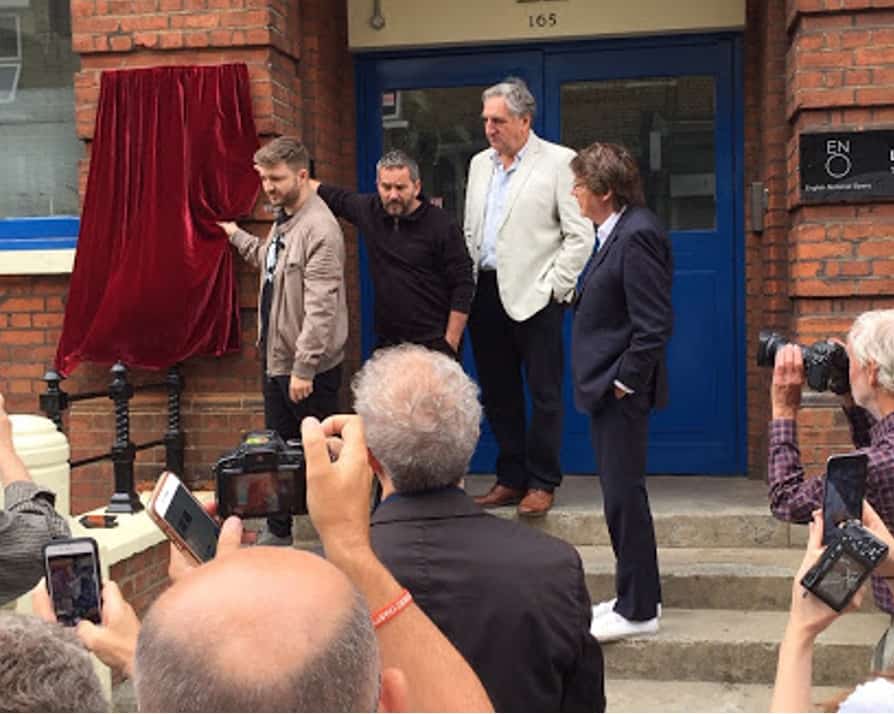
It was sad to hear that Chris Barber, the jazz trombonist and band leader, died aged 90, on 2 March 2021. He was very influential in developing a version of New Orleans jazz in the 1950s which led the way to skiffle, British blues, the Beatles and The Rolling Stones.
A few years ago I had lunch with the late Harold Pendleton and his wife Barbara. Harold was a chartered accountant with a love of jazz, and he told me when he arrived from Southport in 1948 to work in London, the first thing he did was to go to Dobells Record Shop at 77 Charing Cross Road. Harold was thumbing through the jazz racks and got talking to another customer. He was Chris Barber. They became acquainted and Harold became the manager of Chris’ band and a lifelong friend. Harold went on to open the famed Marquee Club in 1958, and with his wife Barbara organised the National Jazz and Blues festivals held in Windsor and later Reading.

In the 1950s Hugh Mendl was a senior producer at Decca who loved jazz and at the 100 Club had heard the new ‘trad’ bands, such as Chris Barber, and was keen to record them. But Decca supremo Edward Lewis did not envisage a viable market for jazz recordings in the 1950s. He told Mendl, ‘Give the boy a radiogram’ as if this would impress Chris Barber and win loyalty to Decca. Mendl replied, ‘I think he already has one’ knowing that Barber possessed a huge record collection. Reluctantly, Lewis offered Mendl a single recording session, as long as it did not cost Decca more than £35. Mendl booked a back-to-back afternoon and evening session at Decca Studios, West Hampstead.
And so, Chris Barber’s band, here comprising Barber (trombone), Pat Halcox (cornet), Monty Sunshine (clarinet), Lonnie Donegan (banjo, guitar & vocals), Jim Bray (bass), and Ron Bowden (drums), arrived at Studio Two to record an album on 13 July 1954, with Mendl producing, and engineered by Arthur Lilly. However, by that evening only five tracks had been laid down. Mendl sent the band to the Railway Hotel next door for a break. When they returned, they jammed a track ‘Merrydown Rag’ after the Merrydown cider they had been drinking in the pub. At this point Mendl pointed out that they still didn’t have enough tracks to complete an album. By 9.30 pm, when some of the band had already left, Lonnie suggested they could do some skiffle. Barber phoned a friend, the singer Beryl Bryden, who lived nearby in Maida Vale and asked her to rush to the studio bringing her washboard.
For this session Lonnie Donegan played acoustic guitar and sang, with Beryl on the washboard. Chris Barber said he was on bass. Mendl looked concerned and told Barber, ‘I don’t want to be unkind, but you’re a trombone player’. ‘Well Hugh ‘I’ve had three lessons from a classical bass player, and I think I can get by!’ replied Barber. In fact, Chris had studied both trombone and double bass at the Guildhall School of Music and frequently played bass when their small group played skiffle.
They laid down ‘Rock Island Line’ and ‘John Henry’ in just a few takes and finished by 10.00 pm. Lonnie later embellished the story claiming that Hugh Mendl didn’t want these tracks and that they were recorded while Mendl was absent on a tea break. But this wasn’t true. In any case ‘Merrydown Rag’ was issued as a single in December 1954 to promote the Barber album, ‘New Orleans Joys’ released in January 1955 while the ‘Bobby Shaftoe’ single was released in March 1955. Neither single entered the charts at this time and initially the album enjoyed only moderate sales.
However later that year in October, the US film ‘The Blackboard Jungle’ appeared featuring enthusiastic teenagers jiving to ‘Rock Around the Clock’ by Bill Haley and the Comets. The resulting single topped the record charts by the end of the month. Decca finally recognised the teenage trend and released Barber’s ‘Rock Island Line’ as a single in November 1955. It began to climb the charts and by January 1956 it had reached number eight. Now the skiffle craze really took off and thousands of teenagers all over the country formed skiffle bands, including The Quarrymen, boasting John Lennon, Paul McCartney and George Harrison. The rest is history.
Following the success of the ‘Rock Island Line’ album, Donegan fell out with Chris Barber, left the band, and dubbed himself the ‘King of Skiffle’. Donegan had more parade hits, such as ‘Cumberland Gap’ and the comedy ‘Does your chewing gum lose its flavour on the bedpost overnight’, not to forget the immortal ‘My Old Man’s a Dustman’. Lonnie Donegan died in 2002. On the 13th July 2019, his son Peter unveiled a Lonnie Donegan memorial plaque on this old Decca Studios building.

Actor and local resident, Jim Carter who also made a TV programme called ‘Lonnie Donegan and Me’ attended the unveiling.
Chris Barber went on to play with a wide range of musicians, and he and Harold Pendelton invited many great US blues men such as Muddy Waters, Howlin’ Wolf, and Big Bill Broonzy to the UK. The link worked both ways, and Chris began to tour the US from the late 50s onwards. His was the first British group to play on the prime-time Ed Sullivan Show. In 1959 he and Monty Sunshine had chart success on both sides of the Atlantic with their version of Sidney Bechet’s, ‘Petite Fleur’ which sold a million records in the UK. In later years Chris also recorded with Van Morrison, Dr John, Mark Knopfler and Eric Clapton.
Return to HIFICRITIC News
© Copyright 2024 Martin Colloms | Terms of Use | Privacy Policy | Cookies | Contact